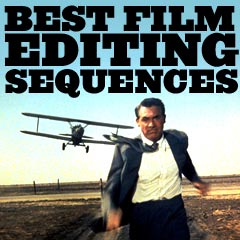
|
| Film Title/ Director & Editor and Film Description | |||||||||||||||||||||||||||||||||||||||||||||||||||||||||||||||||||||||||||||||||||||||||||||||||||||||||||||||||||||
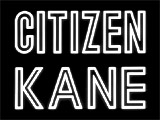
|
d. Orson Welles
This highly-rated classic masterpiece from director-star-producer Orson Welles brought together many cinematic and narrative techniques and experimental innovations (in photography, editing, and sound) to reconstruct the title character like building a jigsaw puzzle. The innovative, bold film is still an acknowledged milestone in the development of cinematic technique, although it 'shared' some of its techniques from many earlier films. Its components brought together the following aspects:
|
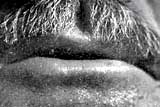 close-ups 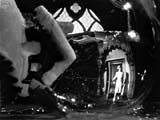 strange camera angles 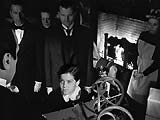 flashforward 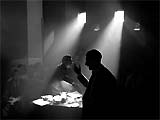 backlighting and high contrast lighting  "deep focus" 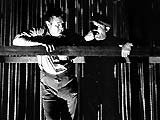 "curtain wipe" |
|||||||||||||||||||||||||||||||||||||||||||||||||||||||||||||||||||||||||||||||||||||||||||||||||||||||||||||||||||
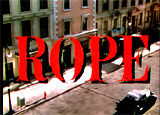
|
Rope (1948) d. Alfred Hitchcock Besides being director Alfred Hitchcock's first feature film in color, this stage-bound experimental thriller was unique for its in-camera 'stunt' - the seamless intercutting of 10 long takes (ranging from approx. 4 and a half minutes to 10 minutes for each take), creating the appearance of the film's action occurring all in 'real-time' in a single, continuous shot of 80 minutes. [Note: The film's actual time frame was closer to 100 minutes.] There were also clever splices between takes (and two brief, reverse-angle shots). The 10 edits alternated between hard cuts (undisguised) and dissolves (invisible or disguised).
A few notable no-cut movies include: Timecode (2000), Russian Ark (2002), and Victoria (2015). Other films like Rope (1948) that were made to appear as 'one-shot' include: Irréversible (2002), Enter the Void (2009), Silent House (2011), Birdman (2014) and 1917 (2019). Some films with long extended one-shot takes (at least over 3 minutes in length) include Touch of Evil (1958), I Am Cuba (1964, Cuba/Soviet Union), Weekend (1967, Fr.), Goodfellas (1990), The Player (1992), Boogie Nights (1997), Snake Eyes (1998), Children of Men (2006), Atonement (2007), Gravity (2013), and One Cut of the Dead (2017, Jp.). |
||||||||||||||||||||||||||||||||||||||||||||||||||||||||||||||||||||||||||||||||||||||||||||||||||||||||||||||||||||
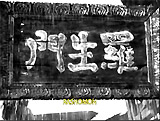
|
Rashomon (1950, Jp.) d. Akira Kurosawa A landmark film in cinematic history, this multi-layered film replayed the same story multiple times from different characters' eyes as they told incompatible, contradictory tales of the same 'rape' and murder in 12th century feudal Japan. The film's timeless theme was the nature of truth and the shaping of perceptions. The four witnesses were:
It was noted that the film had over 400 separate shots seamlessly edited together to make it appear as if there were fewer edits. The film also included inventive tracking shots (especially of the woodcutter, and of the bandit's chase after the couple), a radical flashback structure, unique framing and lighting (shooting directly at the sun through the dense forest branches and leaves), and characters speaking (during the inquest trial) to the "fourth wall" - the film audience. |
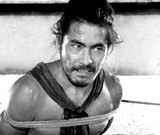 the rapist/bandit 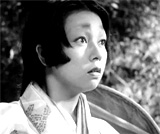 the 'raped' wife 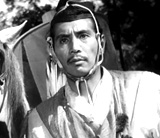 the murdered samurai husband 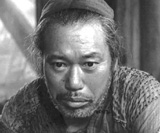 the woodcutter |
|||||||||||||||||||||||||||||||||||||||||||||||||||||||||||||||||||||||||||||||||||||||||||||||||||||||||||||||||||
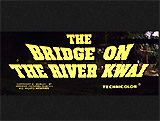
|
The Bridge on the River Kwai (1957)
The exciting finale of the film pitted British Colonel Nicholson (Alec Guinness) - with misguided loyalty to his bridge - against his own Allied commandos. As he proudly walked over the bridge after its completion and leaned over the railing, he noticed wires coming from the bridge but didn't quite understand their significance. Japanese Col. Saito (Sessue Hayakawa), who had taken out a suicidal knife, was alerted by Nicholson: "There's something rather odd going on. I think we'd better have another look around before that train comes across." The two walked down to the water's edge, as the sounds of the chugging and whistling train were heard in the distance coming closer and closer. Nicholson pulled up the detonation wire, and hand-over-fist followed its path to its origin. The Britisher, whose pride in his work took priority over other political/military considerations, attempted to alarm Saito and everyone else that the bridge was mined ("The bridge has been mined!"). From his hiding place near the detonator/plunger poised to blow up the bridge, Lieutenant Joyce (Geoffrey Horne) rushed forward and lethally stabbed Saito in the back. He then identified himself to the astonished Colonel Nicholson: "A British officer. We're here to blow up the bridge, sir!" but Nicholson fought to restrain him. During the scuffle with his own commando, Lt. Joyce was hit and killed by defensive gunfire - followed by a brief camera reaction shot of Joyce's lover - one of the Siamese porter-ladies on the hillside. Next, Shears (William Holden), who was swimming to assist, was wounded in the leg by a shot from a Japanese guard, followed by another quick reaction shot of the face of his Siamese lover, and then a second fatal shot that stopped his progress just within view of Nicholson. Nicholson finally realized he was blocking his own Allied side's operation to blow up the bridge. He gasped: "What have I done?" At the exact moment when the train was passing over the bridge, he was hit by shrapnel from mortars. Nicholson staggered around semi-consciously, and fell mortally wounded on the dynamite plunger.
He blew up his beloved bridge and sent the trainload of Japanese soldiers into the river. The pleasing-to-look-at bridge crumbled and collapsed. |
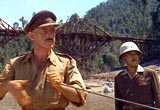  Nicholson with Saito  Nicholson Struggling with Lt. Joyce 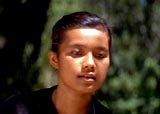 Reaction to Killing of Lt. Joyce 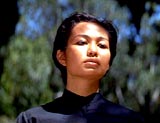 Reaction to Shears Shot and Wounded in Leg 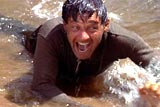 Shears Dying Within View of Nicholson 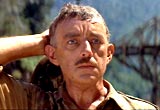 Col. Nicholson: "What have I done?" |
|||||||||||||||||||||||||||||||||||||||||||||||||||||||||||||||||||||||||||||||||||||||||||||||||||||||||||||||||||
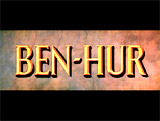
|
d. William Wyler
The film has been most heralded for its classic, memorable and spectacular 11-minute chariot race scene around a central divider strip composed of three statues thirty feet high, and grandstands on all sides, rising five stories high. This sequence set the standard for all subsequent action sequences. The contest between the competitors was highlighted by a series of close-ups of the action. One by one, Messala (Stephen Boyd) eliminated the other drivers in the ferocious race, shattering their chariots. The climactic ending to the race occurred when the chariots of arch-rivals Messala and Ben-Hur (Charlton Heston), in hateful rivalry toward each other, ran neck-and-neck and slashed at each other. At one point, Ben-Hur's horses jumped over a crashed chariot, throwing the hero (stuntman Joe Canutt, son of famed stuntman Yakima Canutt) high into the air, yet he landed on his feet. Messala tried to destroy Ben-Hur's chariot by moving close with the blades, but as the wheels locked and he lost one of his wheels, Messala's chariot was splintered and capsized. He was dragged by his own team, then trampled, and run over by other teams of horses. Defeated, he was left bloody in the dirt, his body broken and horribly injured. |
  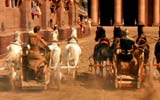     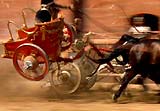
|
|||||||||||||||||||||||||||||||||||||||||||||||||||||||||||||||||||||||||||||||||||||||||||||||||||||||||||||||||||

|
d. Alfred Hitchcock
In the film's most-renowned and brilliantly-edited 7-minute attack sequence with a slow suspenseful buildup - the cornfield crop-dusting sequence - Manhattan businessman Roger Thornhill (Cary Grant) was lured into the flat countryside (of Indiana south of Chicago) by enemy spies. He was led there on the pretext of meeting and connecting with the fabled George Kaplan - his non-existent double. The dapper Roger arrived by bus at a barren road-crossing out in wide-open farm country surrounded by plowed-up dirt and cornfields, incongruously dressed in a neat suit in bright sunlight - in late November of 1958. He was entirely exposed and vulnerable - a modern, urban individual without any amenities or artificial resources - there wasn't even background music on the soundtrack until the climax of the set-piece. Surrealistically, suspense slowly built as cars passed through the desolate area. A truck sprayed him with road dust. A car dropped a man on the other side of the road from him to wait for a bus - was this man Kaplan? A buzzing crop-dusting plane was engaged in dusting a nearby field, when the man remarked that it was odd to have a small plane crop-dusting a crop on a field devoid of crops:
After the man boarded a bus (a symbol of civilization) and it drove away (leaving Thornhill again defenseless and perplexed), the distant, innocent and harmless crop-spraying plane immediately and without warning terrorized him, and swooped down like a bird of prey out of a clear blue sky, causing outright fear and panic. It flew almost at ground level as it sprayed machine-gun fire. Thornhill ducked for cover from the strafing attack, but there was nowhere to hide and no way to defend himself in the vast expanse of the setting. The plane circled and returned a few times as he failed to flag down and stop a car. Thornhill ran for cover in an open cornfield, but the bi-plane showered him with a load of poisonous, white powdery pesticide to flush him out. He returned to the road and ran in front of an approaching semi-trailer Magnum Oil truck - flagging it down and forcing it to stop. He fell under the gasoline truck's front bumper as the plane uncontrollably crashed into the truck's gas tank.
|
        |
|||||||||||||||||||||||||||||||||||||||||||||||||||||||||||||||||||||||||||||||||||||||||||||||||||||||||||||||||||

|
d. Alfred Hitchcock
In the cliffhanger climax, Roger Thornhill (Cary Grant) and Eve Kendall (Eva Marie Saint) were chased and forced to climb down the monument, across the faces of the historical, ex-President figures on Mount Rushmore. Chased by dangerous killers during the descent, they were compelled to start down the sculptures (between Washington and Jefferson) and dangle precariously there off the colossal monument. Leonard (Martin Landau), one of the killers, snatched a prized statue (containing smuggled government microfilm) from Eve's hands and threw her down the rock wall, where she clung for life from a thin ledge. Roger reached down to pull up her outstretched hand, tenuously hanging on to the woman he loved above the abyss. With his other hand, he held on to the rock ledge for support. He appealed to Leonard above him for help, but the evil spy brutally ground and crushed Roger's hand with his foot. A shot rang out, the statue dropped and shattered, and Leonard fell to his death from a policeman's bullet. The Professor (Leo G. Carroll) had arrived just in time to capture and arrest arch criminal Vandamm (James Mason). The witty mastermind spy chided the police after his partner had been shot: "That wasn't very sporting, using real bullets." In a clever transition expressing their physical survival and their new real relationship, Roger continued to struggle in hauling Eve to safety from the rock ledge ("Come on, I've got you. Up...Yes you can, come on") and then - CUT - was abruptly seen pulling her into his upper train berth in a Pullman car: "Come along, Mrs. Thornhill." They were last seen on their honeymoon as they bedded down for the night in their private train compartment. Eve noted: "Oh Roger, this is silly." He replied: "I know, but I'm sentimental." They were returning to their starting point, going east on the train. The film's final shot (an excellent example of double entendre, to avoid censorship laws) was blatantly phallic - their train glided into a tunnel. |
    
|
|||||||||||||||||||||||||||||||||||||||||||||||||||||||||||||||||||||||||||||||||||||||||||||||||||||||||||||||||||